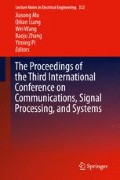Abstract
A bandwidth allocation method based on smartphone users’ personality traits and channel condition is studied in a unified mathematical framework in this paper. Based on the relationship between automatically extracted behavioral characteristics derived from rich smartphone data and Big-Five personality traits, the service provider could estimate each user’s probability of each personality trait using diagnostic inference, and then based on predictive inference to calculate each user’s usage of bandwidth using Bayesian Network. This could help the service provider to better allocate the smartphone bandwidth. For our proposed smart bandwidth allocation scheme, both the outage capacity and the outage probability are studied in fading channel. The service provider could adjust the bandwidth allocated further on account of the real channel condition, which makes our proposed algorithm more robust.
Access this chapter
Tax calculation will be finalised at checkout
Purchases are for personal use only
References
Butt S, Phillips JG (2008) Personality and self reported mobile phone use. Comput Human Behav 24(2):346–360
Chittaranjan G, Blom J, Gatica-Perez D (2013) Mining large-scale smartphone data for personality studies. Pers Ubiquitous Comput 17(3):433–450
Lane W, Manner C (2011) The impact of personality traits on smartphone ownership and use. Int J Bus Soc Sci 2(17):22–28
Lane W, Manner C (2012) The influence of personality traits on mobile phone application preferences. J Econ Behav Stud 4(5):252–260
Liu T, Chen J (2009) Joint downlink transmit and receive beamforming under per-antenna power constraints. In: IEEE 7th international conference on information, communications and signal processing, 2009, pp 1–5
Chen J, Liang Q, Zhang B, Wu X (2013) Spectrum efficiency of nested sparse sampling and co-prime sampling. EURASIP J Wirel Commun Netw 2013(1):47
Chen J, Liang Q, Choi H-A (2012) Spectrum efficiency of nested sparse sampling. In: Wireless algorithms, systems, and applications. Springer, Berlin/Heidelberg, pp 574–583
Chen J, Liang Q, Wang J (2013) Secure transmission for big data based on nested sampling and coprime sampling with spectrum efficiency. Secur Commun Netw. doi:10.1002/sec.785
Chen J, Liang Q, Zhang B, Wu X (2013) A new secure transmission for big data based on nested sampling and coprime sampling. In: The 2nd international conference on communications, signal processing, and systems (CSPS’13)
Bouchaffra D (2012) Mapping dynamic bayesian networks to-shapes: application to human faces identification across ages. IEEE Trans Neural Netw Learn Syst 23(8):1229–1241
Neapolitan RE (2004) Learning bayesian networks. Pearson Prentice Hall, Upper Saddle River
McElroy JC, Hendrickson AR, Townsend AM, DeMarie SM (2007) Dispositional factors in internet use: personality versus cognitive style. MIS Q 31:809–820
Phillips JG, Butt S, Blaszczynski A (2006) Personality and self-reported use of mobile phones for games. CyberPsychol Behav 9(6):753–758
Ehrenberg A, Juckes S, White KM, Walsh SP (2008) Personality and self-esteem as predictors of young people’s technology use. CyberPsychol Behav 11(6):739–741
Devaraj S, Easley RF, Crant JM (2008) Research note - how does personality matter? Relating the five-factor model to technology acceptance and use. Inf Syst Res 19(1):93–105
Tse D, Viswanath P (2005) Fundamentals of wireless communication. Cambridge University Press, Cambridge, ISBN 0521845270
Russell SJ, Norvig P (2010) Artificial intelligence: a modern approach, 3rd edn. Pearson Education, Prentice Hall, Upper Saddle River
Chen J, Liang Q (2014) Rate distortion performance analysis of nested sampling and coprime sampling. EURASIP J Adv Signal Process 1–8
Chen J, Liang Q, (2013) Theoretical performance limits for compressive sensing with random noise. In: Global telecommunications conference (GLOBECOM, (2013) Atlanta. December 2013:3400–3405
Acknowledgements
This work was supported in part by U.S. Office of Naval Research under Grants N00014-13-1-0043, N00014-11-1-0071, N00014-11-1-0865, and U.S. National Science Foundation under Grants CNS-1247848, CNS-1116749, CNS-0964713.
Author information
Authors and Affiliations
Corresponding author
Editor information
Editors and Affiliations
Rights and permissions
Copyright information
© 2015 Springer International Publishing Switzerland
About this paper
Cite this paper
Chen, J., Liang, Q., Wang, J. (2015). Bandwidth Allocation Based on Personality Traits on Smartphone Usage and Channel Condition. In: Mu, J., Liang, Q., Wang, W., Zhang, B., Pi, Y. (eds) The Proceedings of the Third International Conference on Communications, Signal Processing, and Systems. Lecture Notes in Electrical Engineering, vol 322. Springer, Cham. https://doi.org/10.1007/978-3-319-08991-1_28
Download citation
DOI: https://doi.org/10.1007/978-3-319-08991-1_28
Publisher Name: Springer, Cham
Print ISBN: 978-3-319-08990-4
Online ISBN: 978-3-319-08991-1
eBook Packages: EngineeringEngineering (R0)

